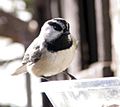Mountain chickadee facts for kids
Quick facts for kids Mountain chickadee |
|
|---|---|
 |
|
| Conservation status | |
| Scientific classification | |
| Genus: |
Poecile
|
| Species: |
gambeli
|
 |
|
| Range of Poecile gambeli | |
| Synonyms | |
|
Parus gambeli |
|
The mountain chickadee (Poecile gambeli) is a small songbird. It belongs to the tit family, Paridae. These birds are known for their lively nature and distinctive calls.
Mountain chickadees are easy to spot with their unique look. Both male and female birds have a black cap on their head. They also have a black stripe behind their eyes, which stands out against their bright white eyebrows. Their backs and sides are gray, and their undersides are a lighter gray. They have a short, black beak and a black patch under their chin, called a bib. An adult mountain chickadee usually has a wingspan of about 19 centimeters (7.5 inches). They are about 13 to 15 centimeters (5 to 6 inches) long.
Contents
Where They Live
Mountain chickadees are very common in the mountains of the western United States. You can find them from the southern Yukon in Canada all the way down to California and the Rocky Mountain States. Some of these birds might move higher up the mountains in the summer. In winter, they might move down into the foothills. However, these movements are not fully understood.
What They Eat
These birds mostly eat insects during the summer and when they are raising their young. They also eat seeds from conifer trees and other plants all year round. Mountain chickadees are clever eaters. They often hang upside down from branches or cling to tree trunks. They search for food hidden in the bark. They can also break open seeds by hitting them with their be beaks.
Reproduction and Life Cycle
Mountain chickadees form pairs and stay with one partner for breeding. They usually have one or two groups of babies each year. The female bird sits on the eggs for about 14 days. When the chicks hatch, they are helpless and need a lot of care. Both parents feed the young birds. The baby chickadees stay in the nest for about 21 days before they are ready to fly out on their own.
Sounds They Make
Mountain chickadees have a special call that sounds like "chick-adee-dee-dee." It's a bit rough or throaty. Their song is a clear, whistling sound with three or four notes. It goes "fee-bee-bay" or "fee-bee-fee-bee." Some people think their song sounds like they are whistling the word "Cheeseburger"!
Social Life
These birds usually travel in pairs or small groups. After the breeding season, they might join larger groups of different bird species. These mixed groups often feed together. Studies have shown that when mountain chickadees are in mixed groups with black-capped chickadees, the black-capped chickadees tend to be more dominant.
How They Got Their Name
The mountain chickadee's scientific name, gambeli, honors a naturalist named William Gambel. Scientists used to place the mountain chickadee in a different group of birds. However, new studies of their DNA and physical features showed they are more closely related to other chickadees. These studies also show that the mountain chickadee is a close relative of the black-capped chickadee.
Gallery
See also
 In Spanish: Carbonero montañés para niños
In Spanish: Carbonero montañés para niños







